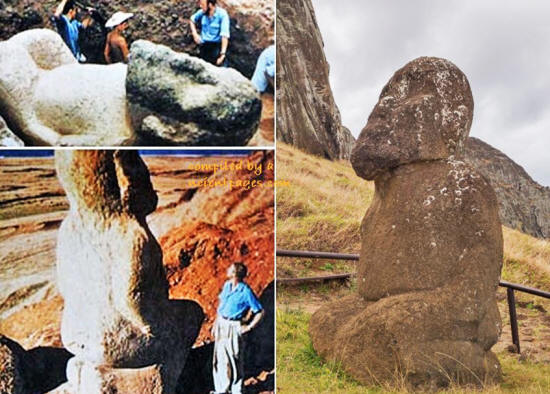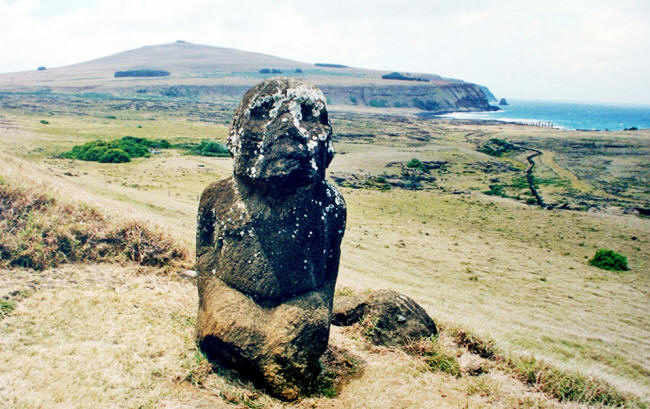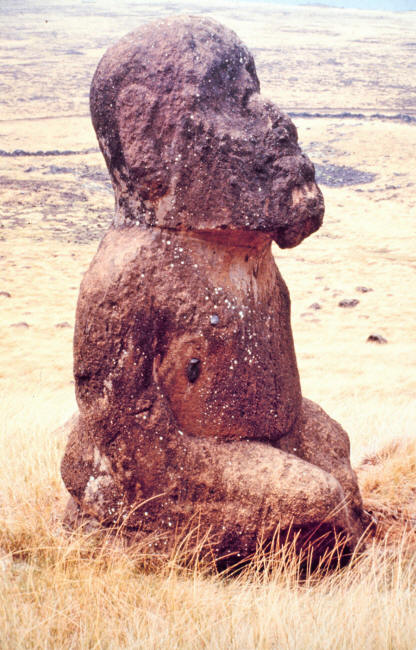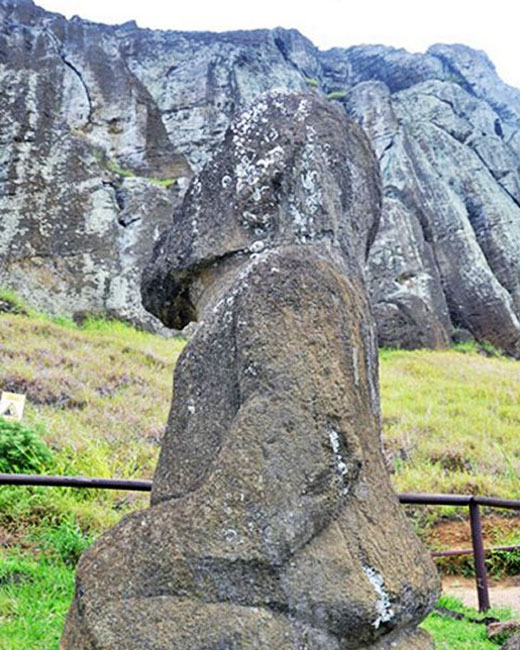|

by A. Sutherland
January
16, 2019
from
AncientPages Website
Similar
Version in spanish

The statue's kneeling position
catches our attention.
Is the kneeling position a way to show
admiration
and respect toward his gods
or is he perhaps, begging for mercy
or forgiveness?
Easter Island keeps many ancient
secrets.
One of them is an
intriguing "kneeling moai" or simply "Tukuturi" figure that was
discovered on Easter Island by archaeologist
Thor Heyerdahl's team in 1955.
The place of this most unusual discovery was the
Rano Raraku quarry.
Curiously, no other
statues accompany this statue, which remains an unusual moai. The
statue of "Tukuturi" is also known as 'tuku turi' or simply 'tuku';
it differs much from many other moai on the Easter Island.
Why is the figure's location away from other sculptures? This figure
differs much from other traditional statues on the island.
Unlike the other stone colossi, Tukuturi's facial characteristics
are rounded, much more human-like when compared to the traditional,
straight rectangular heads of the other moai.
If you look from the side, you could even see that this being has a
small beard. But that's not all.
The figure has also
well-defined legs and it is kneeling with its hands resting on the
knees.
Was Tukuturi a
Famous Figure or Just a Chorus Singer?
One legend says that this is a depiction of a famous moai sculpture
erected to watch over future generations of the island's craftsmen.

The only kneeling Moai at Easter Island.
Photographed by Brocken Inaglory
November of 1998.
Image
via wikipedia
According to an ancient tradition, the posture of the mysterious
"Tukuturi" was used by the men and women who formed the chorus in
the festivals called riu, where the posture was known as' tuku riu'.
Typical also of the singers was the slightly backward inclination of
the trunk, the raised head, and the goatee (a style of facial hair
incorporating hair on a man's chin but not his cheeks), all these
features can be observed in this statue.
Tukuturi is made of red scoria from Puna Pau located on the
outskirts of Hanga Roa in the south west of Easter Island.
Puna Pau is the only
source of red scoria that was used to carve the pukao (topknots)
that they put on the heads of some of their famous moai figures.
However, Tukuturi sits at Rano Raraku, the tuff quarry and it is
believed this statue is probably one of the last moai ever made.
Were
Traditional Moai Created Before Tukuturi or Was He, their
Predecessor?
It is not easy to answer this question and no one knows for sure but
some researchers argue that Tukuturi may belong to a later period.

Tukuturi moai.
source
via wikipedia
Still, the most common idea is that it was one of the first
sculptures to be made - an early precursor of the traditional moai.
However, it wasn't
transported but left in the quarry because it was either damaged or
never intended to be erected on a platform. Perhaps we have to ask
whether the mysterious kneeling Tukuturi really is "moai" figure, in
the first place.
The statue's kneeling position catches our attention.
-
Is the kneeling
position a way to show admiration and respect toward his
gods or is he perhaps, begging for mercy or forgiveness?
-
Is a position of
someone who will be sacrificed?

Among many theories, there is one suggesting that Tukuturi moai is
connected to the Tangata manu cult of Easter Island, a traditional
competition on Rapa Nui, which would make Tukuturi one of the last
moai on the island to have been created.
Tukuturi remains an unsolved mystery because there are no
satisfactorily answers to some crucial questions regarding this
curious figure.
-
Why is the
figure's location away from other sculptures?
-
Why is Tukuturi
kneeling?
-
Why wasn't the
statue created out of the same material like other statues
on the Easter Island?

Birdmen (Tangata manu) paintings
in the so-called "Cannibal Cave".
Storia Illustrata, year 1969.
Image via wikipedia
Father Sebastian Englert (1888 - 1969), a Capuchin Franciscan
friar, Roman Catholic priest, missionary, linguist and ethnologist
from Germany. He is known for his pioneering work on Easter Island.
He said that,
"masters who had
built the beautiful Inca walls of the first period, were not
also the creator of the mighty half figures who have made Easter
Island so famous.
They created a series of simpler statues [like Tukuturi] with a
rounded head and staring eyes, sometimes red tuff and sometimes
of black basalt, but also already used the yellow-gray volcanic
rock, which was so popular in the next period..."
"Aku-.Aku"
T.
Heyerdahl
|






